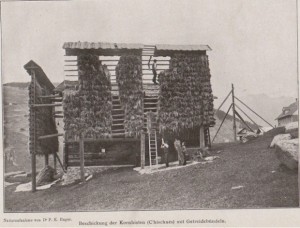Kornhisten
Description
Instruments to enhance post-maturation of cereals: In Alpine cereal cultivation the growth season often is not long enough to allow full ripening before the first snow. Thus it needs to be cut prematurely. To artificially ripen and dry the cereal special means are necessary: Houses have very large storage rooms and open galleries on the sunward site, where the winter rye is left to dry and ripen, before it is threshed (Val Bagnes, Wallis, CH). Vorderrheintal, Eastern Switzerland: Dry structures called "Histen" are located by the fields, where the Foehn wind carries out the drying. Histen are assembled on the southern and western side of stables, which are only connected with planks to the stable but rise to heights above ist roof.
"Telinas" are loggias or verandas attached to the stable with plank structures, on the southern side or in places where the wind triggers drying and ripening.
Often, more than one farmer uses one Histe.
The cereal fascicles are equipped with hooks and attached to a block and tackle or on long planks. The cereal stays 10-20 days on the Histe, before it is threshed.








